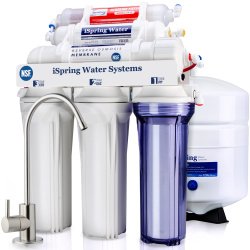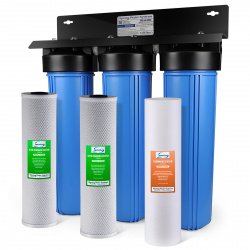
The activated carbon filter is one of the most common filters in water filtration systems. Filtration water pitchers, refrigerator filtration systems, backpacking water filters, home shower head filtration, reverse osmosis systems, and whole-house systems all use activated carbon filtration in some capacity.
Why Activated Carbon?
Most commonly, activated carbon filters are made from coconut shells and have the ability to trap large amounts of chemicals and contaminants through the chemical process of adsorption. One gram of activated carbon has over 32,000 square feet (3,000 square meters) of surface area — and one teaspoon has roughly the area of a football field.
Because it is able to provide this incredibly large surface area and it is a highly porous material, it absorbs impurities effectively.
Activated carbon filters are also versatile and can be used in large-scale products such as municipal water systems as well as small-scale products such as household goods.
Benefits of Using an Activated Carbon Filter
Because activated carbon filters can remove and trap large amounts of chemicals and contaminants, they are highly effective at removing volatile organic compounds (VOCs) such as chlorine, pesticides, herbicides, chloroform, and others that are components of gasoline, industrial solvents, industrial chemicals, and pharmaceutical residues.
Additionally, water can have an unpleasant odor and taste which can be attributed to the presence of organic compounds, chlorine, or sulfur compounds. One common example is chlorine, which is commonly used as a disinfectant in municipal water treatment processes. While chlorine effectively eliminates harmful bacteria, it can leave behind an unpleasant taste and odor in the water. To address this issue, activated carbon is highly effective in removing residual chlorine, resulting in cleaner and fresher-tasting water.
The Science Behind Activated Carbon Filters
During a process called physical adsorption, contaminants adhere to the surface of the carbon material as the water passes through. This adsorption occurs due to the attractive forces between the carbon and the contaminants, allowing the carbon to trap and remove harmful substances from the water and store them in the millions of pores and pockets on the surface of the activated carbon.
Activated carbon also causes chemical reactions that can further remove impurities from water.
While activated carbon filtration is highly effective, the type of carbon used influences what is filtered from the water. There are two types of carbon most commonly used for water filtration: carbon block filter (CTO) and granular activated carbon (GAC). CTO has a smaller particle size than GAC and is typically more efficient at removing a wide range of impurities from the water. However, GAC effectively traps organic chemicals that are comprised of big and heavy molecules with its large holes.
iSpring’s activated carbon filters utilize both CTO as well as GAC to eliminate a higher number of contaminants and utilize PAC to improve the taste of the water.
iSpring’s Systems
While our below-recommended systems utilize multiple activated carbon filters, they also employ other water filtration techniques to provide you and your family with pure drinking water.
Our RCC7AK is a reverse osmosis (RO) purification system that can extract up to 99% of contaminants found in water and employs a second
stage GAC filter and a third-stage carbon block filter. Additionally, this filter
- is NSF/ANSI 58 certified
- uses a 6-Stage Alkaline Remineralization Layered Filtration, exclusively designed to restore the natural alkalinity and mineral balance of water employs an ultra-fine (RO) filter to remove contaminants down to 0.0001 microns
- produces up to 75 gallons of filtered water per day
- uses a pressurized tank to ensure a stable water flow
- features an under-the-sink design takes up minimal counter space
- can be connected directly to the refrigerator’s water supply
Our US31 is an under-the-sink water filtration system that uses a second-stage and third-stage CTO carbon block filters to remove chlorine, tastes, odors, and cloudiness as well as sediment. This filter also
- meets NSF/ANSI standards
- is 20 times more effective than the common water pitcher filtration system
- up to 1 GPM depending on source water pressure
- easy installation and low maintenance
- clear see-through 1st stage housing
Much like the US31, our WGB32B uses a second-stage and third-stage CTO carbon block filters to remove chlorine, tastes, odors, and cloudiness as well as sediment from your water. However, this system is installed at the point of entry and works to filter water supplied to your whole house. Additionally, this filter
- removes up to 95% of sediment, rust, pesticides, herbicides, industrial solvents, and various other contaminants
- Is installed at the main water supply line in order to treat all the water in your home
- meets NSF/ANSI standards
- has a capacity of 100,000 gallons of water
- protects household appliances and plumbing system from sediment, rust, dirt, sand, and large particles
- extends the life of your standard filters
Each of these filters improves the taste and odor of the drinking water as well as removes chlorine, and other potentially harmful substances.
While our systems are able to provide you and your family with superior water, it is imperative to keep in mind that filtration systems only function effectively if properly maintained. Once all the surface area of activated carbon is filled with contaminants, it is crucial it be replaced so you can continue to enjoy pure, clean drinking water.
For more information, please reach out to our customer care team.



